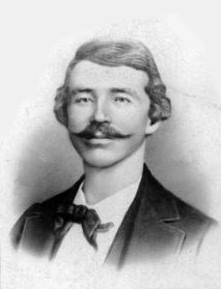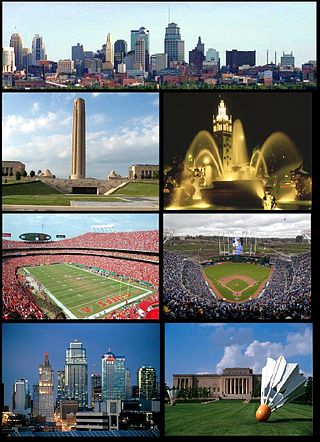Related Research Articles

Kansas City is the third-most populous city in the U.S. state of Kansas, and the county seat of Wyandotte County. It is an inner suburb of the older and more populous Kansas City, Missouri, after which it is named. As of the 2020 census, the population of the city was 156,607, making it one of four principal cities in the Kansas City metropolitan area. It is situated at Kaw Point, the junction of the Missouri and Kansas rivers. It is part of a consolidated city-county government known as the "Unified Government". It is the location of the University of Kansas Medical Center and Kansas City Kansas Community College.

William Clarke Quantrill was a Confederate guerrilla leader during the American Civil War.

The Kansas City metropolitan area is a bi-state metropolitan area anchored by Kansas City, Missouri. Its 14 counties straddle the border between the U.S. states of Missouri and Kansas. With 8,472 square miles (21,940 km2) and a population of more than 2.2 million people, it is the second-largest metropolitan area centered in Missouri and is the largest metropolitan area in Kansas, though Wichita is the largest metropolitan area centered in Kansas. Alongside Kansas City, Missouri, these are the suburbs with populations above 100,000: Overland Park, Kansas; Kansas City, Kansas; Olathe, Kansas; Independence, Missouri; and Lee's Summit, Missouri.

The Lawrence Massacre was an attack during the American Civil War (1861–65) by Quantrill's Raiders, a Confederate guerrilla group led by William Quantrill, on the Unionist town of Lawrence, Kansas, killing around 150 unarmed men and boys.

Arthur Capper was an American politician from Kansas. He was the 20th governor of Kansas from 1915 to 1919 and a United States senator from 1919 to 1949. He also owned a radio station, and was the publisher of a newspaper, the Topeka Daily Capital.

Jayhawker and red leg are terms that came to prominence in Kansas Territory during the Bleeding Kansas period of the 1850s; they were adopted by militant bands affiliated with the free-state cause during the American Civil War. These gangs were guerrillas who often clashed with pro-slavery groups from Missouri, known at the time in Kansas Territory as "Border Ruffians" or "Bushwhackers". After the Civil War, the word "Jayhawker" became synonymous with the people of Kansas, or anybody born in Kansas. Today a modified version of the term, Jayhawk, is used as a nickname for a native-born Kansan.

The sacking of Lawrence occurred on May 21, 1856, when pro-slavery settlers, led by Douglas County Sheriff Samuel J. Jones, attacked and ransacked Lawrence, Kansas, a town that had been founded by anti-slavery settlers from Massachusetts who were hoping to make Kansas a free state. The incident fueled the irregular conflict in Kansas Territory that later became known as Bleeding Kansas.
The timeline of Kansas details past events that happened in what is present day Kansas. Located on the eastern edge of the Great Plains, the U.S. state of Kansas was the home of sedentary agrarian and hunter-gatherer Native American societies, many of whom hunted American bison. The region first appears in western history in the 16th century at the time of the Spanish conquest of the Aztec Empire, when Spanish conquistadors explored the unknown land now known as Kansas. It was later explored by French fur trappers who traded with the Native Americans. It became part of the United States in the Louisiana Purchase of 1803. In the 19th century, the first American explorers designated the area as the "Great American Desert."
Thomas Wilson Williamson was a Kansas architect who specialized in designing school buildings in Kansas, Iowa, and Missouri.

Samuel Johnson Crawford was a Union Army officer during the American Civil War, and the third Governor of Kansas (1865–1868). He also served as one of the first members of the Kansas Legislature.

James Northrup Atkinson was an American football coach and politician. He was the first recorded head football coach at Ottawa University in Ottawa, Kansas and he held that position for two seasons, from 1901 until 1902. His career coaching record at Ottawa was 12–5–2. Ottawa University football dates back to 1891, but the teams either played without a coach or no coaching records were kept.
Fort Baxter, also known as Fort Blair, was a small US Army post located in the southeast corner of Kansas near present-day Baxter Springs. This area was known as the Cherokee Strip. It was one of a few Kansas forts attacked by Confederate forces during the American Civil War. At one point the Confederate government claimed authority over the Neutral Lands. Both Union and Confederate troops operated in the area, as did guerrilla forces and militias prevalent in the Kansas-Missouri border area.
On March 7, 1862, Confederate guerrillas under William C. Quantrill raided the small Kansas community of Aubry, southwest of Kansas City, Missouri, and just west of the Kansas-Missouri border. Three residents were killed in the raid and much property was carted away by the guerrillas.
The following is a timeline of the history of Topeka, Kansas, USA.
Franklin is a ghost town in Douglas County, Kansas, United States. Established as a proslavery stronghold, the town played a key role in the "Bleeding Kansas" conflict that troubled the territory in the 1850s.
Franklin's Fort was a small fortification that had been erected in Franklin, Douglas County, Kansas by pro-slavery settlers. During the "Bleeding Kansas" period, the fort was the site of two minor battles between pro- and anti-slavery factions.

Oscar Eugene Learnard was a campaigner for Free State Kansas, a Republican organizer, a colonel in the Union Army during the American Civil War, a railroad official, a two-term Kansas State Senator, and a school administrator.
Otis Berthoude Gunn was a railroad engineer and Kansas state senator who received an appointment to serve as a major in the Fourth Volunteer Kansas regiment in the Union Army during the American Civil War, and later in the Tenth Kansas Infantry. He served on governor George F. Robinson's staff. The Historical Society of Kansas has a collection of his and his family's papers.
Richard Josiah Hinton was a journalist, author, abolitionist, and military officer with the rank of colonel. He was the commander of African-American soldiers in the American Civil War, Freedmens Bureau official, and U.S. government official.
References
- ↑ CONNELLEY, William Elsey, in Who's Who in America (1901-1902 edition); p. 234; via archive.org
- 1 2 3 4 William Elsey Connelley, at Wyandotte Nation; archived at archive.org, August 14, 2010; retrieved April 27, 2024
- ↑ Amazon website, at https://www.amazon.com/Quantrill-Border-William-Elsey-Connelley/dp/1163211222 .
- ↑ WorldCat website, at http://www.worldcat.org/title/quantrill-and-the-border-wars/oclc/580948 .
- ↑ The University of Kansas Libraries website, at http://etext.ku.edu/view?docId=ksrlead/ksrl.kc.connelleywilliamelsey.xml;route=ksrlead;brand=ksrlead;query= .
- ↑ Trm Creative Services website, at http://www.trmscreativeservices.com/kac/historyPady.html#bios .
- ↑ Organization of American Historians website, at http://www.oah.org/about/oah/past-officers/ .
- ↑ "William Elsey Connelley Papers, 1878-1931". Kansas Historical Society . Retrieved January 24, 2024.
- ↑ "William E. Connelley Collection". Kansas City Kansas Public Library . Retrieved January 24, 2024.
- ↑ "William E. Connelley Interviews". Truman State University. Archived from the original on January 24, 2024. Retrieved January 24, 2024.
- ↑ "William Elsey Connelley Papers". University of Kansas Kenneth Spencer Research Library. Archived from the original on January 24, 2024. Retrieved January 24, 2024.
- ↑ "William E. Connelley Collection". University of Oklahoma Libraries's Western History Collections. Archived from the original on January 24, 2024. Retrieved January 24, 2024.